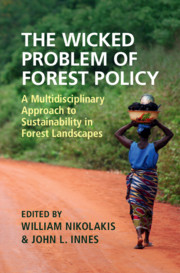 The Wicked Problem of Forest Policy
The Wicked Problem of Forest Policy Book contents
- The Wicked Problem of Forest Policy
- The Wicked Problem of Forest Policy
- Copyright page
- Contents
- Contributors
- 1 The Wicked Problem of Forest Policy
- Part I Wicked Problems and Policies
- Part II Tools to Address Wicked Problems
- 9 The Wicked Problems of Indonesia’s Forests Require Effective Institutions to Resolve Difficult Trade-Offs
- 10 Power to the Forest People
- 11 How Are Land-Use Multi-stakeholder Fora Affected by Their Contexts?
- 12 Sustainable Landscape Investment
- 13 Community Forestry in Liberia
- 14 Are Some Forestry Problems Too Wicked?
- Index
- References
13 - Community Forestry in Liberia
Progress and Pitfalls
from Part II - Tools to Address Wicked Problems
Published online by Cambridge University Press: 24 July 2020
- The Wicked Problem of Forest Policy
- The Wicked Problem of Forest Policy
- Copyright page
- Contents
- Contributors
- 1 The Wicked Problem of Forest Policy
- Part I Wicked Problems and Policies
- Part II Tools to Address Wicked Problems
- 9 The Wicked Problems of Indonesia’s Forests Require Effective Institutions to Resolve Difficult Trade-Offs
- 10 Power to the Forest People
- 11 How Are Land-Use Multi-stakeholder Fora Affected by Their Contexts?
- 12 Sustainable Landscape Investment
- 13 Community Forestry in Liberia
- 14 Are Some Forestry Problems Too Wicked?
- Index
- References
Summary
Community forestry has long been regarded as a way to achieve the sustainable management of forest and tree resources while maximizing benefits for those responsible for the custodianship of natural resources. Throughout much of the developing world, forests and the lands they occupy have been increasingly ceded to the management and control of Indigenous peoples and local communities. In the post-conflict environment of Liberia, community forestry has been identified as a means of maximizing the engagement of local communities in forest management initiatives. Liberia’s recent comprehensive National Forestry Policy is an important step forward in this process. The new legislative framework makes it clear that a major reorientation of the forestry sector is required if it is to successfully address the economic challenges facing the country. These challenges concern the need to substantially improve forest governance and to ensure that the forest sector contributes more effectively to the alleviation of poverty and livelihood improvement. While, on paper, the legal framework for community forestry is robust, implementation is falling short due to conflicts over land and resources that have pervaded the Liberian forestry sector for decades. Increased investment in oil palm expansion, artisanal agriculture and broader government-supported logging activities all threaten the implementation of community forestry. Concomitantly, a fundamental lack of capacity at the community level and at the level of the Forestry Department has curtailed early attempts to operationalize community forestry in the country. In this chapter we explore the evolution and development of community forestry in Liberia, and assess prospects for its future implementation. We provide a clear framework of recommendations to address potential constraints to its success.
- Type
- Chapter
- Information
- The Wicked Problem of Forest PolicyA Multidisciplinary Approach to Sustainability in Forest Landscapes, pp. 354 - 375Publisher: Cambridge University PressPrint publication year: 2020
References
- 1
- Cited by


